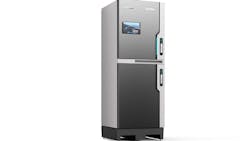The transition to Industry 4.0 brings with it a shift in the perception of industrial hydraulics. For decades, antiquated stereotypes of how hydraulics were seen and used in manufacturing have prevailed, but with advancements in technology and development, those misconceptions are being refuted.
Let’s address some of the most prevalent and long-held beliefs in the hopes of seeing industrial hydraulics in a new light and consider how innovation is positively impacting this critical power source.
Myth: Power Units Are Noisy
It’s one of the first things you notice when you step onto a factory floor—the noise. We’re all familiar with the infamous whine and whir of hydraulic pumps and presses. However, with advancements in hybrid technology with electrification, hydraulic power units are now quieter and, in many instances, help manufacturers stay compliant with OSHA standards.
Current regulations in the United States require sustained noise levels to be below 85 decibels over a standard 8-hour day and units like Bosch Rexroth’s CytroBox are well below that threshold.
Myth: Power Units Are Big and Bulky
Not only are hydraulic power units quieter, but they’re also taking up less space. One of the interesting developments in modern manufacturing is the emphasis on lean work environments with scaled-down solutions. Real estate for these factories can be expensive and companies are understandably trying to maximize output from a smaller footprint. The hydraulic power units that power many of their processes, which once occupied a space of 6 ft2 or larger, are now less than half of that; if they were the size of a kitchen before, now they’re about the size of a closet.
The aforementioned hybrid technology of variable-speed drives and hydraulic pumps allows for consolidated solutions that don’t sacrifice output or quality while maintaining a minimal physical footprint.
Myth: Power Units Are Hard To Maintain
One of the downsides of the transition to Industry 4.0 is the shortage of skilled hydraulic workers who have been servicing units for decades. That knowledge base is waning with their continued retirement, which leaves an increased need for not only responsive and preventative maintenance services but also predictive. Fortunately, certain advancements in hydraulic units include measures that account for that.
The connectivity of hydraulic units in Internet of Things (IoT) processes is proving to be a game-changer. Manufacturers have an established line of communication with vendors who can see in real-time how their hydraulic systems are performing and, in many cases, diagnose potential issues before they occur.
Bosch Rexroth’s answer to this is through its CytroConnect monitoring platform that comes standard with every CytroBox. The impact this has on maintaining productivity, extending the life of products, and overall cost-savings can be extensive. Gone are the days of waiting for a technician to come and address the problem in person, which inevitably slowed down production and put a strain on the workforce.
Industrial hydraulic maintenance is in a much more proactive position now in addressing these issues and manufacturers need to leverage IoT-capable solutions to ensure peak performance.
As manufacturing processes enter a new era, OEMs and end-users alike should prioritize solutions that use proven technology but also embrace emerging trends. The latest editions of industrial hydraulic power units are a perfect example of this and represent a futureproof solution that consistently delivers high productivity in a sleeker, smaller, and quieter design.
Christopher Parisse is a Controls Product Engineer for Industrial Hydraulics at Bosch Rexroth.

